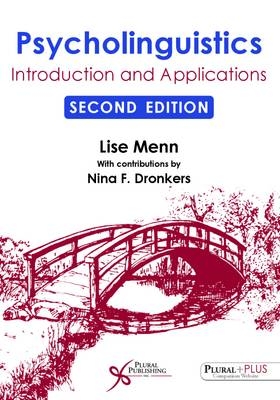
Psycholinguistics
Plural Publishing Inc (Verlag)
978-1-59756-712-1 (ISBN)
Psycholinguistics: Introduction and Applications, Second Edition is the first textbook in psycholinguistics created for working language professionals and students in speech-language pathology and language education, as well as for students in psychology and linguistics. It provides a clear, lively introduction to research and ideas about how human brains process language in speaking, understanding, and reading. Within a unifying framework of the constant interplay of bottom-up (sensory) and top-down (knowledge-based) processing across all language uses and modalities, it is an integrated, self-contained, fully updated account of psycholinguistics and its clinical and pedagogical applications. In this second edition, author Lise Menn is joined by leading brain researcher and aphasiologist, Nina Dronkers. The significantly revised brain chapter contains current findings on brain structure and function, including the roles of newly-delineated fiber tracts and language areas outside Broca's and Wernicke's areas.Five core chapters (language description, brain structure and function, early and later stages of speech production, experimental psycholinguistics) form the foundation for chapters presenting classical and recent research on aphasia, first language development, reading, and second language learning.
A final chapter demonstrates how linguistics and psycholinguistics can and should inform classroom and clinical practice in test design and error analysis, while also explaining the care that must be taken in translating theoretically based ideas into such real-world applications. Concepts from linguistics, neurology, and experimental psychology are kept vivid by illustrations of their uses in the real world, the clinic, and language teaching. Technical terms are clearly explained in context and also in a large reference glossary. The text is now accompanied by a web-based Student Workbook. The Instructor's Manual, also new, is flexibly organized for instructors and students of varying backgrounds.Key Features:*Written in clear, vivid, straightforward style by experienced professors with varying student needs and instructor backgrounds in mind.*Explicit, attractive presentation of clinical and pedagogical applications.*
Covers a range of phenomena from normal, partially-learned, and impaired language, such as phonological dialect variation, semantic category priming and garden-path sentences; alteration of the brain by language experience, overgeneralization, and failure to generalize; aphasia, oral apraxia, perseveration.*Complete glossary of technical terms that are also clearly explained throughout the text.*Companion website has sound files, help with learning the International Phonetic Alphabet and anatomical terms, color versions of text figures, and a compact version of the experimental psycholinguistics section for students with backgrounds in psychology.*NEW! Companion website includes wide range of supplemental research information about language, psycholinguistics, and neurolinguistics.*NEW! Web-based Student Workbook with problems, self-quizzes, links to additional resources, and optional advanced material.*NEW! Web-based Instructor's Manual, outlining key concepts and source materials for each section, suggesting discussion topics and instructional activities, and providing explanations and answers for Student Workbook problems.
Lise Menn, Professor Emerita, University of Colorado, has taught courses in linguistics, language development, psycholinguistics, and neurolinguistics at the University of Colorado, Boulder and other schools since 1977. She has carried out collaborative research on aphasia with colleagues in many countries and has presented lectures, workshops, and short courses on the practical value of thinking psycholinguistically about language learning and language disorders in Australia, Belgium, Brazil, China and Taiwan, Finland, Germany, Japan, the Netherlands, Singapore, Sweden, the United Kingdom, and the United States.
Introduction: Psycholinguistics and What It's Good For. Chapter 1. Basic Linguistics: How to Describe Language Use and Language Knowledge. Chapter 2. Brains and Language, Nina Dronkers and Lise Menn. Chapter 3. Normal Speech Errors and How They Happen: I. From Idea to Word. Chapter 4. Normal Speech Errors and How They Happen: II. Saying Words and Sounds in the Right Order. Chapter 5. Experimental Studies of Normal Language Production and Comprehension: An Introduction to Experimental Methods in Psycholinguistics and Neurolinguistics. Chapter 6. Analyzing Aphasic Speech and Communication: The Psycholinguistics of Adult Acquired Language Disorders. Chapter 7. Developmental Psycholinguistics: Studies of First Language Acquisition. Chapter 8. The Psycholinguistics of Reading and Learning to Read. Chapter 9. First and Second Language Acquisition: A Psycholinguistic Approach to Their Similarities and Differences. Chapter 10. Using Psycholinguistics in Testing, Teaching, and Therapy. Afterword: Other Important Areas for Applying Psycholinguistics.
| Erscheinungsdatum | 08.01.2016 |
|---|---|
| Zusatzinfo | illustrations |
| Verlagsort | San Diego |
| Sprache | englisch |
| Maße | 178 x 254 mm |
| Themenwelt | Geisteswissenschaften ► Sprach- / Literaturwissenschaft ► Sprachwissenschaft |
| Medizin / Pharmazie ► Gesundheitsfachberufe ► Logopädie | |
| ISBN-10 | 1-59756-712-4 / 1597567124 |
| ISBN-13 | 978-1-59756-712-1 / 9781597567121 |
| Zustand | Neuware |
| Haben Sie eine Frage zum Produkt? |
aus dem Bereich


